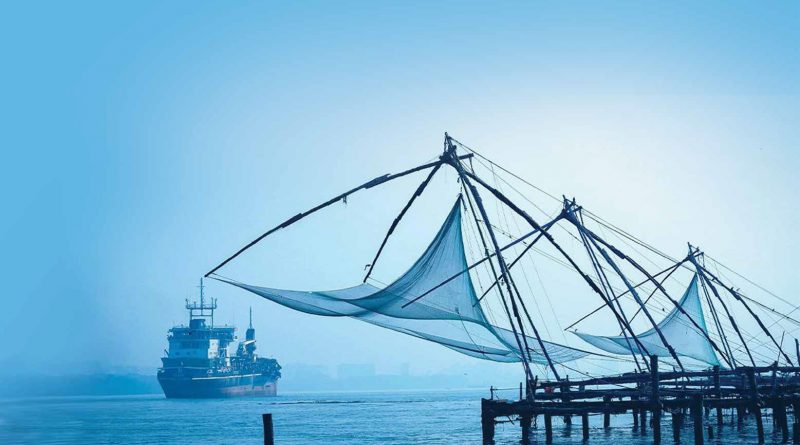THE GLORY AND BEAUTY OF KOCHI
Kochi, known to be the commercial capital of Kerala, is the first destination for the tourists and center of trade and business. Kochi is blessed with Kochi Kayal, part of Vembanadu Lake, which encompasses several islands spread across the Greater Kochi region and is part of the City of Kochi. Kochi houses one of the busiest major ports in western India, which is close to international shipping channels due to its geographical location on the Indian peninsula and frequently called upon by major cruise ships. The container transshipment terminal, Vallarpadom is strategically located in Kochi, near to the international shipping channel. Rich in its maritime history, Kochi region had a special place in history with maritime trade for many centuries with its spice trade and had trade relations with the Arabs, Chinese, and Europe from ancient port of Muziris, kodungalloor. With the devastating floods in the fourteenth century, when the Port of Kodungalloor was destroyed and the creek of Kochi was opened, which developed as a Port. In the early twentieth century, the British wanted to develop it and the Port of Kochi was developed as a major Port by extensive dredging and the formation of the man-made island Willingdon island by legendary British engineer Robert Bristow.
Kerala, known in the world tourism map as God’s own Country, is among the list of top 50 destinations across the globe by Time Magazine and others. The Kerala backwaters are a unique experience and beautiful ecosystem that supports a rich diversity of flora and fauna. Vembanadu Lake, one of the largest lakes in India, stretches across many districts of Kerala, forming the largest brackish lagoon. It is thriving in tourism activities, which is one of the major economic activities of the state and a major income source for a vast population.
 The Islands of Kochi are thickly populated and culturally inclusive and the islanders depend on the City of Kochi not only for earning their livelihood but also for trade, business, health care, education, etc. The primary means of their transport were traditionally waterborne, with a range of vessels from local canoes known as “vanchy”, to diesel-powered Boats till the end of the last century. Traditional boats “Kettuvallom” were used to transport goods by the local traders to far away interiors and distant towns.
The Islands of Kochi are thickly populated and culturally inclusive and the islanders depend on the City of Kochi not only for earning their livelihood but also for trade, business, health care, education, etc. The primary means of their transport were traditionally waterborne, with a range of vessels from local canoes known as “vanchy”, to diesel-powered Boats till the end of the last century. Traditional boats “Kettuvallom” were used to transport goods by the local traders to far away interiors and distant towns.
With the development of connecting bridges and roads in the early nineties, especially through the newly built Goshree bridges, transport largely shifted to motor vehicles, and with economic advancement, the tendency was shifted to the use of private vehicles for their transportation needs. The water transport slowly started deteriorating and most of the privately run Boats disappeared from the routes and only vintage type government supported initiatives survived, that too in a dilapidated state. Few of the islands, which are not yet connected by any bridges and roads, remained as islands of limited reach and correspondingly underreached and under-developed, however continuing to amaze with their serene beauty.
The ever-increasing private vehicles at a fast pace, along with the weakening of one of the most efficient public transport modes, among similar trends in the mainland posed fresh challenges to the city of augmenting the rush in city roads, ever-increasing traffic jams, slow pace of movement, accidents, higher pollution levels and chaos in parking spaces. As of today, there’s one vehicle for every two persons in the state as a whole and when it is on city skirts this is an even higher figure. The need for a sustainable system of transportation was the need of the hour for the city dwellers, who traditionally used public transport for more than 50% of their transport needs. Kochi Metro Rail was one of the first steps towards a mass transport system in the city that started its operation in 2017, credited as one of the fastest-built metros in India and the most modern. Today, more than a lakh commuters use the Metro daily, probably lifting out a very large number of private vehicles from the road and reducing the sizeable quantity of Greenhouse gas emissions saving the planet.
Along with the conceptualization of Kochi Metro in the main arterial road, the need for an integrated transport system with all modes of public transport has been identified as important as a comprehensive solution for the city and improving the living standards of the people of Kochi. The use of abundant water bodies, by rejuvenating the water transport system was one of the best solutions, towards a socially inclusive development of the islanders and city dwellers. The idea of Kochi Water Metro was born as a natural outcome of inclusive thinking.


